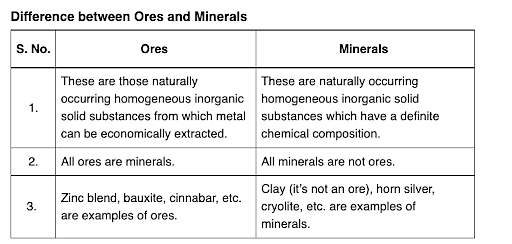Which of the reaction is suitable for concentrating ore by leaching process?
- \(2 Cu _2 S +3 O _2 \rightarrow 2 Cu _2 O +2 SO _2\)
- \(Fe _3 O _4+ CO \rightarrow 3 FeO + CO _2\)
- \(Al _2 O _3+2 NaOH +3 H _2 O \rightarrow 2 Na \left[ Al ( OH )_4\right]\)
- \(Al _2 O _3+6 Mg \rightarrow 6 MgO +4 Al\)
The Correct Option is C
Solution and Explanation
The suitable reaction for concentrating ore by leaching process is:
\(Al _2 O _3+2 NaOH +3 H _2 O \rightarrow 2 Na \left[ Al ( OH )_4\right]\)
This is because the reaction involves the conversion of the metal oxide (in this case, aluminum oxide) into a water-soluble form (sodium aluminate), which can be easily separated from the impurities in the ore through leaching. Leaching involves dissolving the desired metal compound using a suitable solvent, in this case, sodium hydroxide solution. This process allows for the concentration of the ore by selectively dissolving the desired metal compound while leaving behind the impurities.
So, the correct option is (C).
Top Questions on General Principles and Processes of Isolation of Elements
- In the extraction of iron using blast furnace to remove the impurity (X), chemical (Y) is added to the ore. X and Y are respectively
- TS EAMCET - 2025
- Chemistry
- General Principles and Processes of Isolation of Elements
- What is used for the Thermite Reaction?
- BCECE - 2025
- Chemistry
- General Principles and Processes of Isolation of Elements
- Which of the following compounds is used to cover the surface of a metallic object to prevent corrosion?
- KEAM - 2025
- Chemistry
- General Principles and Processes of Isolation of Elements
A block of mass 1 kg is pushed up a surface inclined to horizontal at an angle of \( 60^\circ \) by a force of 10 N parallel to the inclined surface. When the block is pushed up by 10 m along the inclined surface, the work done against frictional force is:

[Given: \( g = 10 \) m/s\( ^2 \), \( \mu_s = 0.1 \)]
- BITSAT - 2024
- Physics
- General Principles and Processes of Isolation of Elements
A parallel plate capacitor with plate area \(A\) and plate separation \(d = 2\) m has a capacitance of \(4\mu F\). The new capacitance of the system if half of the space between them is filled with a dielectric material of dielectric constant \(K = 3\) (as shown in the figure) will be:

- BITSAT - 2024
- Physics
- General Principles and Processes of Isolation of Elements
Questions Asked in JEE Main exam
- The value of \( (\sin 70^\circ)(\cot 10^\circ \cot 70^\circ - 1) \) is:
- JEE Main - 2025
- Trigonometric Identities
- Let \( \alpha_1 \) and \( \beta_1 \) be the distinct roots of \( 2x^2 + (\cos\theta)x - 1 = 0, \ \theta \in (0, 2\pi) \). If \( m \) and \( M \) are the minimum and the maximum values of \( \alpha_1 + \beta_1 \), then \( 16(M + m) \) equals:
- JEE Main - 2025
- Binomial Expansion
- A particle moves on a circular path of radius 1 m. Find its displacement when it moves from \( A \rightarrow B \rightarrow A \). Also, its distance are it moves from \( A \rightarrow B \rightarrow A \).
- JEE Main - 2025
- Projectile motion
- A transparent film of refractive index 2.0 is coated on a glass slab of refractive index 1.45. What is the minimum thickness of transparent film to be coated for the maximum transmission of green light of wavelength 550 nm?
- Match the Compounds (List- I) with the appropriate Catalyst/Reagents (List- II) for their reduction into corresponding amines.

- JEE Main - 2025
- Organic Chemistry
Concepts Used:
General Principles and Processes of Isolation of Elements
What are Ores and Minerals?
Minerals are the naturally occurring, homogeneous inorganic solid substances. They are having a definite chemical composition and crystalline structure, hardness and color. For example, copper pyrite, calamine, etc.

Impurities in an ore are called gauge. The removal of a gauge from the ore is called concentration ore.
Several steps are involved in the extraction of pure metal from ores. Major steps are as follows –
- Concentration of the ore
- Isolation of the metal from its concentrated ore
- Purification of the metal